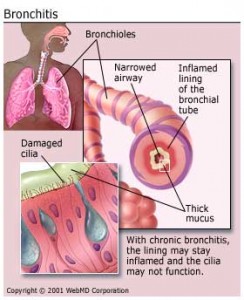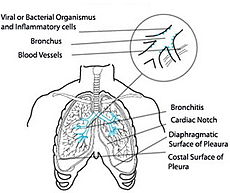HomeDivisionsLung DiseaseBronchitis
 Bronchitis is a respiratory disease in which the mucus membrane lining of the bronchial tubes (bronchi) in the lungs becomes inflamed.
Bronchitis is a respiratory disease in which the mucus membrane lining of the bronchial tubes (bronchi) in the lungs becomes inflamed.
The bronchial tubes are air passages that extend from the trachea (windpipe) into the small airways and tiny air sacs (alveoli) of the lungs.
As the lining of the bronchial tubes swells or gets infected, the mucus membrane thickens and eventually shuts off the airways.
The irritated bronchial passages make it difficult for patients to breath because oxygen cannot easily reach their lungs.
Patients often cough up heavy mucus called sputum or, in some cases, phlegm (mucus with bacteria and debris).
Other symptoms of bronchitis include shortness of breath, wheezing, and chest tightness in the airways.
The disease can affect both adults and children.
Bronchitis is one of the main conditions for which patients seek medical care in the United States.
The condition may be acute (lasting less than a few weeks) or chronic (long-term with a duration of at least three months).
Risks of bronchitis include:
- Cigarette smoking
- Exposure to a large amount of secondhand smoke
- Weakened immune system
- Gastroesophageal reflux disease (GERD)
- Exposure to lung irritants (chemical fumes, vapors, grains, textiles), often in the workplace
Air pollution is a risk for acute bronchitis in preschool-aged kids.
Polluted air contains air particulates (PAHs) produced as by-products of vehicle exhaust, wood-burning stoves, tobacco smoke, coal burning, and grilling food.
Acute Bronchitis
 Acute bronchitis usually lasts one to three weeks, and develops after a cold or upper respiratory infection such as the flu.
Acute bronchitis usually lasts one to three weeks, and develops after a cold or upper respiratory infection such as the flu.
The infection moves into the bronchial tree – a network of respiratory structures located between the lungs and trachea — resulting in a hacking cough, sometimes with green sputum.
Other symptoms consist of chest discomfort or soreness, fever, and sometimes shortness of breath.
About 90 percent of cases are caused by a virus, with the remaining 10 percent triggered by bacterial infections.
Common viral causes of acute bronchitis consist of respiratory viruses that infect the upper respiratory tract such as influenza viruses A and B, parainfluenza viruses, adenovirus, respiratory syncytial virus, herpes simplex virus, rhinovirus, coxsackievirus groups A and B, and echovirus.
Acute bronchitis may also be caused by bacterial germs (pathogens) such as Mycoplasma pneumoniae and Chlamydophila pneumoniae.
Symptoms of acute bronchitis may include:
- Inflammation of the bronchi (inflammed bronchial tubes)
- Coughing
- Sore throat
- Fever
- A cough with production of clear, white, yellow, grey, or green sputum
- Chest congestion, pain or discomfort
- Shortness of breath, particularly with exertion.
- Wheezing
- Chills
- Body aches
- Nasal congestion (blocked or runny nose)
- Fatigue
Diagnosis of Acute Bronchitis
Acute bronchitis is diagnosed during a medical exam and based on clinical symptoms such as wheezing or abnormal sounds of the lungs.
Family or personal medical histories may also reveal the likelihood that a patient has bronchitis.
Laboratory examinations include blood tests and sputum culture (a test to evaluate mucus coughed up from the lungs) to identify any bacterial cause.
An elevated temperature may indicate that bacterial bronchitis is present.
Chest X-rays may be needed to differentiate between bronchitis and pneumonia.
The doctor may also make oxygen saturation measurements to determine the amount of oxygen being carried by red blood cells.
Treatment of Acute Bronchitis
Bronchitis in healthy individuals is usually self-limiting, meaning that the disease resolves spontaneously on its own with or without specific treatment.
Antibiotics are not prescribed because acute bronchitis is generally caused by a virus. (Antibiotics are used primarily to treat bacterial infections.)
Patients are advised to rest, drink fluids, and breath warm and moist air.
They may be instructed to use therapies to reduce symptoms such as analgesics (such as acetaminophen), antipyretics (such as ibuprofen), antitussives (such as dextromethorphan), and expectorants (such as, guaifenesin).
If the patient has bacterial bronchitis as revealed on a positive sputum culture, then erythromycin or azithromycin may be prescribed.
Prognosis of Acute Bronchitis
The prognosis for acute bronchitis is good, although this condition may cause worsen the health of patients with an underlying heart or lung pulmonary disease.
Complications of acute bronchitis are rare but may include:
- Bacterial superinfection
- Pneumonia
- Chronic bronchitis with repeated episodes of acute bronchitis
- Reactive airway disease
- Hemoptysis (coughing up of blood or bloody sputum from the lungs)
Prevention measures of acute bronchitis include:
- Quit smoking
- Avoid secondhand smoke
- Maintain a clean environment
- Receive a yearly influenza vaccine between October and December
- Receive the pneumonia vaccine every 5-10 years (for those over 65 years of age or with chronic disease)
- Avoid people who are sick, especially with colds or the flu
- Wash hands regularly
- Avoid cold, damp locations or places with high levels of air pollution
- Wear a mask around people who are coughing and sneezing
Chronic Bronchitis
Chronic bronchitis is a common but serious Chronic Obstructive Pulmonary Disease (COPD), a progressive disorder that makes breathing difficult. Chronic bronchitis lasts three months or more per year for two consecutive years if there is no secondary cause of the cough.
The disease tends to occur during winter, and may improve or worsen during different times of the year.
The cough is more severe in the mornings and in damp weather. In 2006, nearly 9.5 million people were diagnosed with chronic bronchitis in the United States.
Almost 90 percent of cases of chronic bronchitis and chronic obstructive pulmonary disease are due to cigarette smoking. Smoking has several adverse effects on the lungs. For example, cigarette smoking may cause the cells in the mucus-secreting glands of the mucosa of large airways made of cartilage to enlarge (hypertrophy) and abnormally increase in number (hyperplasia).
Chronic bronchitis can also be caused by exposure to air pollution, chemical fumes, dust, and toxic gases for an extended period of time.
Multiple episodes of acute bronchitis may trigger chronic bronchitis.
Regardless of the culprit, the irritated bronchi produce excessive mucus that can trigger cough spells with excessive phlegm as well as breathlessness.
Symptoms of chronic bronchitis may include:
- Cough and sputum production daily for at least 3 months
- Shortness of breath
- Wheezing
- Fatigue
- Sore throat
- Muscle aches
- Nasal congestion (blocked or runny nose)
- Headaches
- Chest pain due to severe coughing
- Cyanosis (bluish/grayish skin coloration) (in patients with advanced COPD)
- Fever (due to secondary viral or bacterial lung infection)
Diagnosis of Chronic Bronchitis
A diagnosis of chronic bronchitis is based on the patient’s medical history (including daily cough with sputum production for at least three months), a physical exam, and diagnostic tests.
Specific tests to confirm a diagnosis may include:
- Chest X-ray
- Complete blood count (CBC)
- Arterial blood gas measurements
- CT scan of the chest
- Pulmonary function tests to evaluate lung function
Treatment and Prevention of Chronic Bronchitis
The main types of medications used to treat this condition are:
- Bronchodilators
- Steroids
- PDE4 inhibitors, a new class of anti-inflammatory drugs, approved by the FDA for worsening symptoms of COPD
Other therapies include:
- Antibiotics (for chronic bronchitis caused by bacterial infections)
- Pulmonary rehabilitation (smoking cessation education and breathing techniques)
- Supplemental oxygen therapy
Prognosis for Chronic Bronchitis
The prognosis is good in patients diagnosed before extensive bronchial damage had occurred and who stop smoking or who avoid air pollutants early in the course of the disease.
Almost 50% of smokers with chronic bronchitis will stop coughing about one month after they have quit smoking. Prognosis is poor in patients who experience ongoing bronchial irritation and inflammation.
These individuals are at risk for a higher rate of coughing, breathing problems and further deterioration of lung function.
Major complications of chronic bronchitis include:
- Breathing problems, sometimes serious
- Respiratory failure
- Pneumonia
- Cor pulmonale (enlargement and weakness of right heart ventricle from lung disease)
- Pneumothorax (buildup of air or gas in lung leading to collapsed lung)
- Polycythemia (abnormally high concentration of red blood cells that transport oxygen)
- COPD
- Emphysema (another common type of COPD)
- Chronic progression of the disease
- Fatality (chronic bronchitis has a high death rate)
Prevention Measures of Chronic Bronchitis include:
- Quit smoking
- Avoid secondhand smoke
- Maintain a clean environment
- Receive a yearly influenza vaccine between October and December
- Receive the pneumonia vaccine every 5-10 years (for those over 65 years of age or with chronic disease)
- Avoid people who are sick, especially with colds or the flu
- Wash hands regularly
- Avoid cold, damp locations or places with high levels of air pollution
- Wear a mask around people who are coughing and sneezing
- Avoid air-borne chemicals, dust, and other irritants at home and in the workplace
- Control asthma
Asthmatic Bronchitis
Patients with both asthma and bronchitis may develop asthmatic bronchitis, or inflammation of the lining of the bronchial tubes.
Prevention through healthy lifestyle changes can make a difference in reducing the risk of bronchitis. People experiencing any symptoms of bronchitis – short-term or especially long-term — should consult a medical doctor immediately.
References
- Acute bronchitis. familydoctor.org. 2010.
http://familydoctor.org/familydoctor/en/diseases-conditions/acute-bronchitis.html.
Accessed 4/2/13. - Acute bronchitis – Topic Overview. webmd.com. 2010. Accessed 4/2/13.
- Chronic bronchitis. familydoctor.org. 2010.
http://familydoctor.org/familydoctor/en/diseases-conditions/chronic-bronchitis.html.
Accessed 4/1/13. - Fayyaz J. Bronchitis. Medscape. 2011.
http://emedicine.medscape.com/article/297108-overview#a0101. Accessed 4/1/13. - NIH: National Heart, Lung, and Blood Institute. Acute bronchitis. Medline Plus. http://www.nlm.nih.gov/medlineplus/acutebronchitis.html. Accessed 4/1/13.
http://www.nlm.nih.gov/medlineplus/ency/article/001087.htm. Accessed 4/1/13. - NIH: National Heart, Lung, and Blood Institute. Chronic bronchitis. Medline Plus. http://www.nlm.nih.gov/medlineplus/chronicbronchitis.html. Accessed 4/1/13.
- Schiffman G. Chronic bronchitis. Medicinenet.com. 2011. http://www.medicinenet.com/chronic_bronchitis. Accessed 4/2/13.
- Thompson E. Chronic bronchitis. WebMD. 2011.
http://www.webmd.com/lung/chronic-bronchitis. Accessed 4/2/13. - Wedro B. Acute bronchitis. Medicinenet.com. http://www.medicinenet.com/bronchitis/symptoms-acute-bronchitis/article.htm. Accessed 4/2/1.





